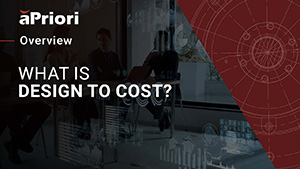DTC Meaning: What is Design to Cost?
Design to Cost or DTC is a critical initiative in the manufacturing industry that integrates cost management with decision-making in real-time. What is Design to Cost? Design to Cost is an organizational methodology and business model that integrates cost management with decision-making right at the design stage.
In the traditional approach, the design team would first create a product design, and then the individual inputs would be priced by a cost engineer. In a fuel system, for example, a vehicle manufacturer would first design the mechanical system, and then pass the design to a cost engineer who would be responsible for pricing the ignition system, onboard computer, fuel injector, and any inputs for the powertrain. The cost engineer would send any diagnostic trouble codes back to the design engineer, to asses whether changes to reduce cost might lead to vehicle malfunction or vehicle problems. This back-and-forth led to considerable downtime and delay in time to market. Moreover, this business model creates inefficiencies by missing opportunities for cost reduction, by bypassing the first character cost drivers that most impact the direct-to-consumer cost.
DTC Reduces Downtime By Targeting Cost Early
Design to Cost or DTC fundamentally changes this approach. DTC integrates cost estimation and analysis at the design stage, shifting the focus of cost reduction away from arbitrary targets. In a Design to Cost environment, costs are directly tied to the design decisions driving them. This transforms cost from a post hoc business target to an independent variable within the design process.
The power of Design to Cost lies in its ability to influence the total cost of a direct-to-consumer product. The design phase is where design engineers can evaluate inputs to influence up to 70% of a product’s final cost. This is because the design decisions made at this stage have a ripple effect. DTC codes cost into all stages of the product lifecycle, including manufacturing process, supply chain, sustainability considerations, and ultimately, the product’s life cycle cost.
What Does It Take to Implement Design to Cost or DTC?
Implementing Design to Cost requires a serious commitment from manufacturing companies. It’s not just about introducing a new cost methodology into your business model. It’s about making cost management an integral part of the culture within the design team and the wider organization. DTC means investing in innovative tools for reducing fault codes and elevating cost estimation to a primary contributor to business success.
DTC Case Study
For an example of what DTC can do for a company, consider Spirit AeroSystems (an aerospace parts maker). Using aPriori, Spirt was alerted to a part that exceeded cost targets. aPriori revealed that an inexperienced designer made a series of unnecessary aesthetic choices, which drove up overall costs by 10%. Spirit was able to pinpoint this cost overrun in the design phase, rather than during the more costly development phase.
In conclusion, Design to Cost is a transformative approach to product development. DTC empowers design engineers to make informed decisions that balance cost, value, and functionality. By integrating cost management into the design process, manufacturers can create more cost-effective products, improve profitability, and deliver greater value to their customers.


